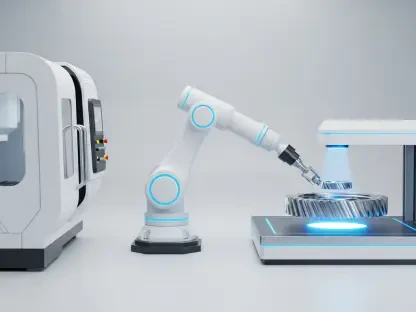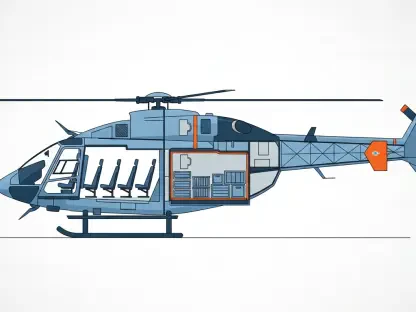The evolution of Computer Numerical Control (CNC) machines has been monumental in revolutionizing the manufacturing industry, integrating unparalleled precision and advanced automation to meet the rising demands for efficiency and quality. As the industry strides towards 2032, the global CNC machine market is projected to soar to a staggering USD 162.16 billion. Several factors contribute to this anticipated growth, including profound technological advancements, heightened market demand, and significant regional developments, which collectively signal a promising future for CNC machinery.
Rising Demand for Precision and Automation
The relentless pursuit of accuracy and consistency in manufacturing processes is a significant catalyst driving the expansion of the CNC machine market. These sophisticated machines are unparalleled in performing highly accurate operations, such as drilling, milling, and cutting—processes essential in sectors like aerospace, automotive, electronics, and metalworking. The move towards automation not only minimizes human error but also ensures consistent quality, amplifying overall productivity in the manufacturing sphere.
In modern manufacturing landscapes, where precision is non-negotiable, CNC machines’ ability to meet stringent requirements places them as invaluable assets. The automated operations these machines perform elevate production efficiency and permit high levels of customization and flexibility. Such adaptability is increasingly vital, especially in today’s fast-paced production environments where responsiveness and precision can often distinguish market leaders from laggards.
The automation capabilities of CNC machines streamline operations, reduce the margin for error, and uphold rigorous standards. Whether it’s producing complex geometries or executing micro-level tasks, CNC technology proves indispensable, offering unparalleled accuracy while reducing the need for manual intervention. The rise in demand for such precision and automation underscores the critical role CNC machines play in contemporary manufacturing.
Technological Advancements Driving Innovation
The swift pace of technological advancements profoundly influences the capabilities and functionalities of CNC machines. The integration of groundbreaking technologies like the Internet of Things (IoT), Artificial Intelligence (AI), and Machine Learning (ML) heralds a new era in CNC operations, characterized by enhanced productivity and efficiency. These advancements facilitate real-time monitoring, predictive maintenance, and advanced data analytics—capabilities that are paramount for optimizing operational performance and minimizing downtime.
IoT enables seamless connectivity between machines and systems, promoting better communication and data sharing that streamline workflows. On the other hand, AI and ML algorithms empower CNC machines to learn from experiential data, making informed decisions that can significantly optimize the manufacturing process. These synergies set new standards for efficiency, precision, and reliability in the CNC domain, driving unprecedented levels of innovation.
The incorporation of IoT, AI, and ML into CNC machines is redefining the industry landscape. Real-time monitoring through IoT enhances the ability to track machine performance and health, ensuring timely interventions that prevent costly downtimes. AI and ML imbue machines with the capability to anticipate issues, recommend maintenance schedules, and continuously learn to improve processes. These technological integrations exemplify the convergence of digital and mechanical worlds, fostering smarter, more autonomous manufacturing environments.
Cost Efficiency and Productivity Gains
Despite the significant initial investment required for CNC machines, with prices ranging from USD 30,000 to USD 500,000 per unit, the long-term benefits far surpass the initial costs. High-end CNC machines, integrated with advanced technologies such as multi-axis systems and automated tooling, offer considerable savings in labor costs and drastically improve productivity. These machines enable manufacturers to achieve more with less, establishing them as key drivers of efficiency in the manufacturing sector.
Manufacturers who invest in CNC technology often experience substantial reductions in production times and error rates, which are crucial in industries where precision and time are of the essence, such as automotive and aerospace. This long-term cost efficiency justifies the substantial expenditure, positioning CNC machines as a strategic investment for companies striving to maintain a competitive edge in the market.
By reducing the reliance on manual labor, CNC machines minimize the risk of human error, ensuring consistent quality and precision in production outputs. The advanced capabilities of these machines, such as complex geometrical cuts and high precision in repetitive tasks, not only enhance productivity but also improve material utilization and reduce waste. This multi-faceted cost efficiency makes CNC technology a cornerstone in the drive towards more sustainable and competitive manufacturing processes.
Market Expansion Across Key Sectors
The CNC machine market is witnessing rapid expansion across pivotal sectors, particularly automotive and aerospace. In these high-stakes industries, the focus on reducing production costs and enhancing efficiency drives the adoption of CNC technologies. Automated CNC processes ensure exceptional precision and faster production turnaround times, catering to the escalating demand for high-quality and cost-effective manufacturing solutions.
In the extensive industrial sector, which includes manufacturing industries such as packaging, electronics, and medical fields, CNC machines hold the largest market share. Their capability to execute intricate tasks with minimal human oversight underscores their essential role in these industries. The ability to handle complex designs and materials, from robust automotive components to delicate medical instruments, positions CNC technology as pivotal in various manufacturing ecosystems.
The market expansion is fueled by the need for innovation and technological integration across these key sectors. As industries evolve, the demand for advanced CNC systems capable of high precision and low operational costs continues to rise. The adaptability and automation provided by CNC machines address these requirements, making them indispensable in sectors that prioritize efficiency and quality.
Dominance of the Asia Pacific Region
The Asia Pacific region stands out as a dominant force in the global CNC machine market, largely due to its rapid industrialization, substantial technological advancements, and robust manufacturing outsourcing services. Valued at a significant portion of the global market share, this region’s influence is underscored by the prolific production and innovation of CNC technologies, prominently led by countries such as China and Japan.
China and Japan excel in CNC machine production, with numerous companies within these countries constantly pushing the envelope in CNC innovation to enhance manufacturing capabilities. Their focus on technological enhancement and production efficiency drives regional growth and solidifies their status as leaders in the CNC market. The region’s strong industrial base, combined with a culture of innovation, positions it as a pivotal player shaping the future of CNC technology.
The dominance of the Asia Pacific region is further cemented by its competitive and diverse industrial landscape. From electronics and automotive sectors to heavy machinery and precision engineering, the varied applications of CNC machines across industries ensure sustained demand and innovation. As the region continues to lead in technological advancements and production expertise, its influence within the global CNC market is poised to expand further.
Contributions from North America and Europe
North America and Europe remain integral to the global CNC machine market, with their established industries and continued investments in advanced manufacturing technologies. These regions are at the forefront of improvements in precision, efficiency, and the integration of emerging technologies like AI and IoT in CNC systems, fostering advancements that further drive the market.
Both regions prioritize technological integration to elevate manufacturing standards, emphasizing the adoption of CNC machines for enhanced productivity and precision. This focus aligns with broader industrial automation trends, reinforcing North America and Europe’s positions as key markets for CNC technology. The commitment to innovation and high-quality manufacturing continues to drive the uptake of sophisticated CNC systems in these technologically advanced regions.
The ongoing investments in AI and IoT in CNC technology within these regions represent a concerted effort to maintain competitive advantages in global markets. These advancements not only enhance the functionality and efficiency of CNC machines but also align with industry goals for sustainable and smart manufacturing practices. By continually spearheading technological integration, North America and Europe ensure their significant roles in shaping the future landscape of CNC manufacturing.
Major Industry Players and Strategic Initiatives
The CNC machine market thrives on the contributions of several leading companies, including AMADA MACHINERY CO., LTD., DMG MORI CO., LTD., FANUC CORPORATION, Haas Automation, Inc., OKUMA Corporation, YAMAZAKI MAZAK CORPORATION, and Siemens AG. These key players are at the vanguard of CNC technology innovation, constantly exploring new frontiers to enhance machine performance and market reach.
Recent strategic initiatives underscore this relentless pursuit of excellence. For instance, Mitsubishi Electric India CNC’s partnership with SolidCAM and OKUMA Corporation’s launch of next-generation machine control represent significant strides in product development and market positioning. These collaborative efforts and innovations are crucial in maintaining a competitive edge, driving the evolution of CNC technology and its market expansion.
By focusing on continuous improvement and strategic collaborations, these industry leaders set new benchmarks for innovation and efficiency in CNC manufacturing. Their commitment to advancing CNC technology not only drives market growth but also ensures the development of cutting-edge solutions to meet the evolving needs of the manufacturing sector. These strategic initiatives highlight the dynamic nature of the CNC market and the persistent drive towards excellence and innovation.
Integration of IoT and AI for Smarter Manufacturing
The advancement of Computer Numerical Control (CNC) machines has been pivotal in transforming the manufacturing industry. These machines offer unmatched precision and cutting-edge automation, addressing the growing need for efficiency and high-quality production. As we approach 2032, it’s projected that the global CNC machine market will skyrocket to an impressive USD 162.16 billion.
Multiple factors are driving this anticipated growth. Technological innovations have dramatically improved the capabilities of CNC machines, making them faster, more accurate, and easier to operate. This advancement means manufacturers can produce complex parts with minimal human intervention, reducing errors and production costs.
Furthermore, the increased demand from various industries, including automotive, aerospace, and medical devices, is spurring the adoption of CNC technology. These industries require highly precise components, and CNC machines are well-suited to meet these stringent demands.
Significant developments in different regions are also contributing to this growth. In Asia-Pacific, for example, the manufacturing sector is rapidly expanding, driving up the demand for advanced CNC machinery. In North America and Europe, there’s a strong focus on upgrading existing manufacturing technologies to stay competitive in the global market.
Overall, the future of CNC machining looks extremely promising, with technological advancements and increased market demands paving the way for even greater innovations and growth in coming years.









